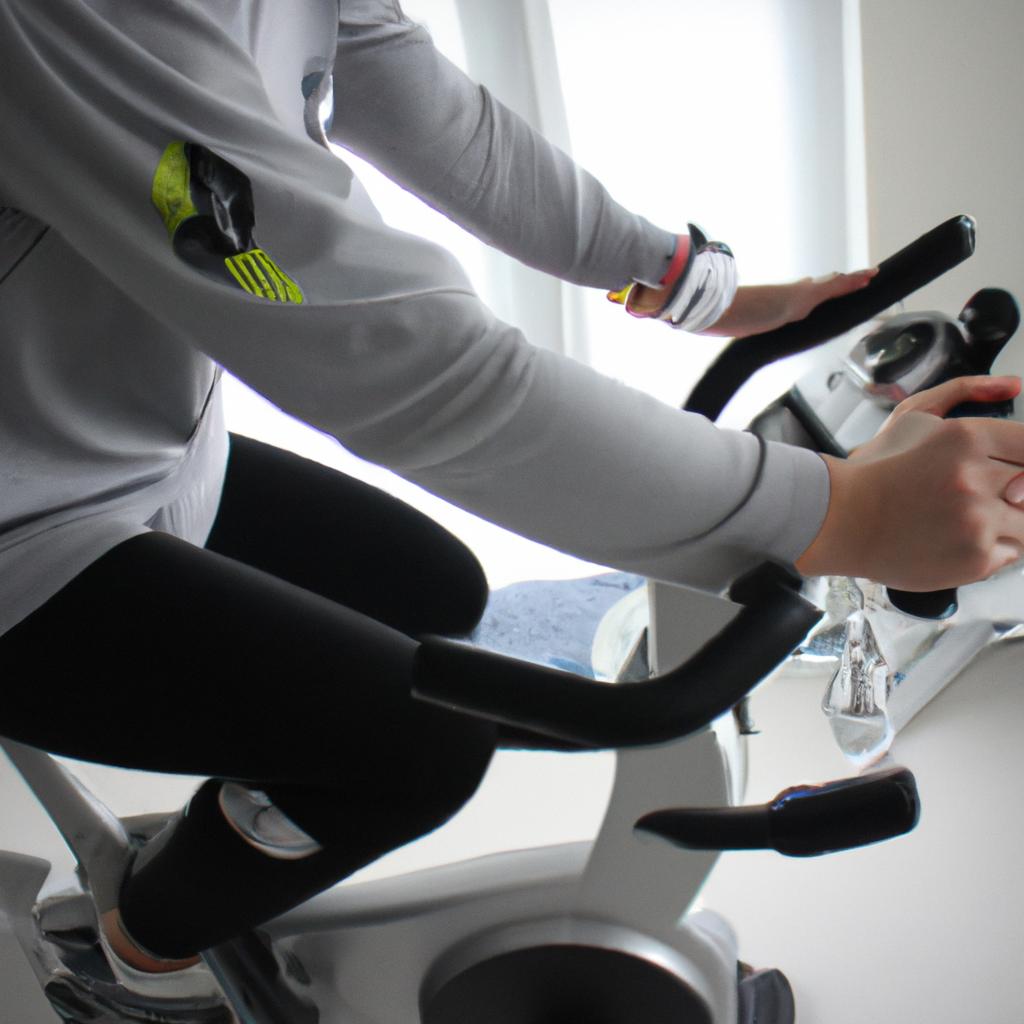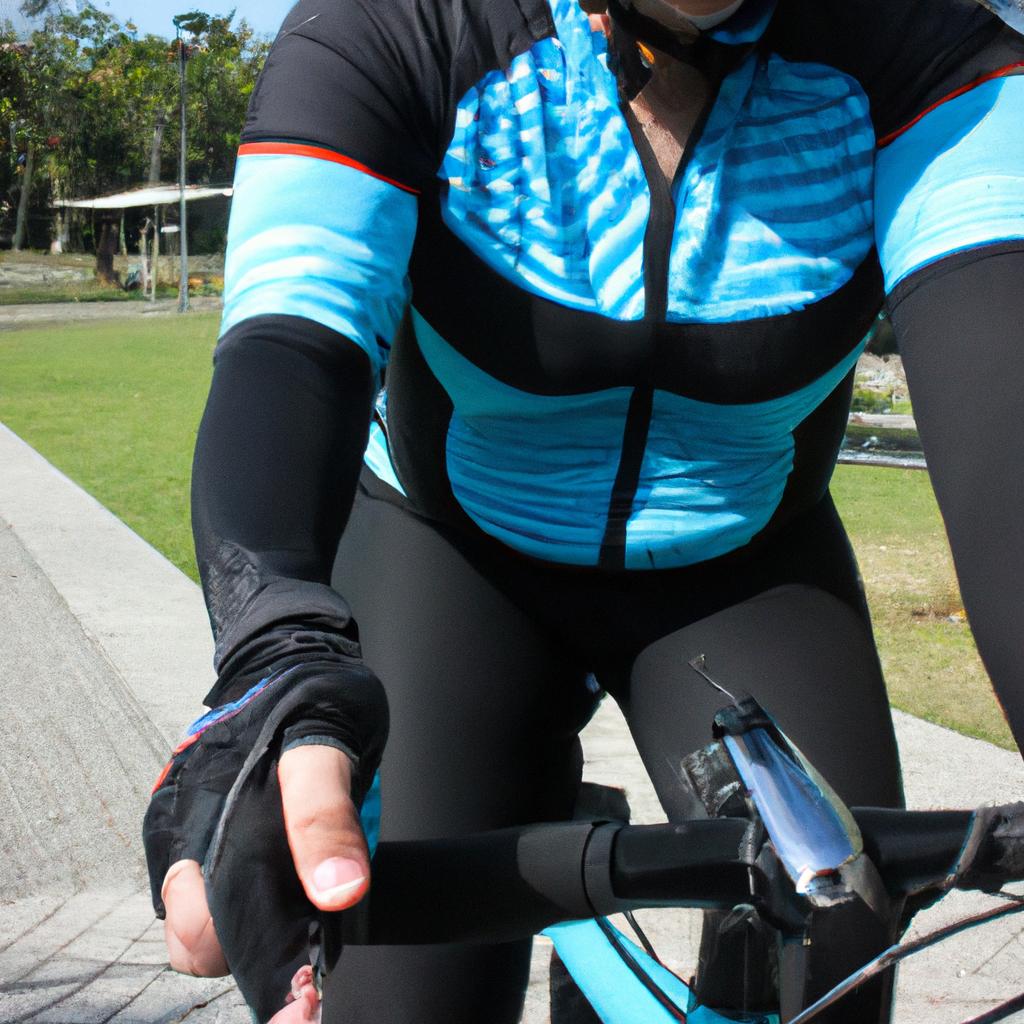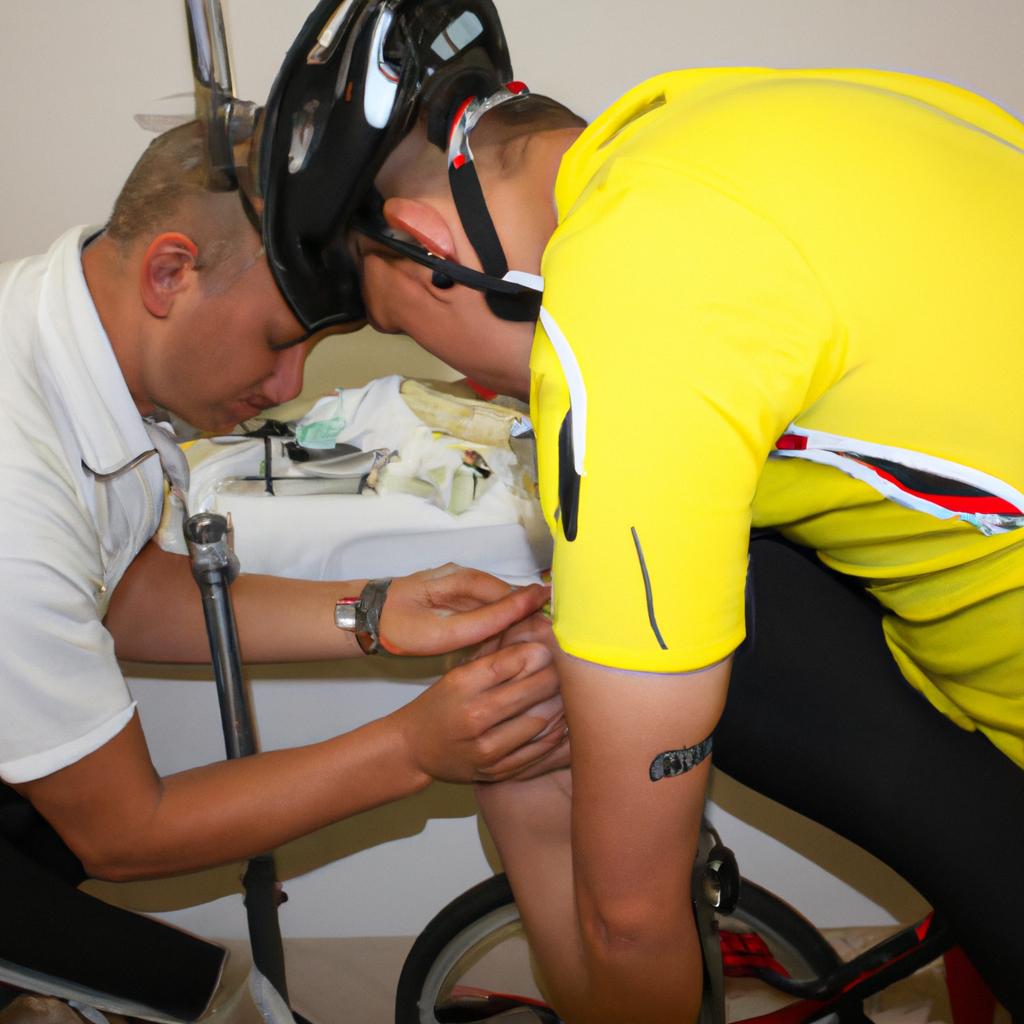Preventing Cycling Injuries: A Comprehensive Guide for Sports Cyclists

In recent years, the popularity of cycling as a recreational and competitive sport has soared. However, along with its numerous benefits come inherent risks of injury. Consider the case of John, an avid cyclist who suffered a severe knee injury during a long-distance race. This unfortunate incident not only forced him to halt his training but also resulted in significant medical expenses and lengthy rehabilitation. To prevent such occurrences and promote safe cycling practices, it is crucial for sports cyclists to be well-informed about effective injury prevention strategies.
With the aim of enhancing knowledge and awareness among sports cyclists, this comprehensive guide delves into various aspects related to preventing cycling injuries. Firstly, it explores common types of injuries experienced by cyclists, providing valuable insights into their causes and potential risk factors. By understanding these factors, riders can proactively identify situations that may increase their vulnerability to accidents or mishaps on the road or trails.
Secondly, this article highlights essential preventive measures that can significantly reduce the likelihood of sustaining cycling-related injuries. From proper equipment selection and regular maintenance to adopting correct riding techniques and adhering to traffic regulations, implementing these recommendations will undoubtedly enhance safety while enjoying the thrills of cycling. Furthermore, special attention is given to specific areas prone to injury in order to provide practical guidance on preventing and managing knee, shoulder, and lower back injuries.
For knee injuries, the guide emphasizes the importance of proper bike fit and pedal stroke technique to minimize stress on the joints. It also suggests incorporating strength and flexibility exercises into training routines to improve stability and prevent overuse injuries.
When it comes to shoulder injuries, riders are advised to maintain a relaxed upper body posture and avoid excessive strain during climbs or sudden movements. Strengthening exercises for the rotator cuff muscles can help increase stability and reduce the risk of dislocations or strains.
In terms of lower back injuries, the article recommends maintaining a neutral spine position while riding and engaging in core-strengthening exercises to support the lower back muscles. It also highlights the significance of gradually increasing mileage and intensity to prevent overloading the back.
Additionally, the guide provides tips on proper warm-up and cool-down routines, as well as suggestions for cross-training activities that can complement cycling training and promote overall fitness and injury prevention.
By equipping sports cyclists with knowledge about potential injury risks and effective preventive measures, this comprehensive guide aims to empower riders to make informed decisions that prioritize their safety on every ride. Through increased awareness and adherence to best practices, cyclists like John can continue pursuing their passion for cycling while minimizing the chances of experiencing debilitating injuries.
Understanding Common Cycling Injuries
Imagine this scenario: John, an avid sports cyclist, recently experienced a sharp pain in his knee after a long ride. He was unable to continue cycling and sought medical attention. This case highlights the importance of understanding common cycling injuries and taking necessary precautions to prevent them.
Cycling is a physically demanding sport that can put strain on various parts of the body. The repetitive motion involved in pedaling coupled with external factors such as terrain and weather conditions can increase the risk of injury. It is crucial for cyclists to be aware of these potential injuries to minimize their occurrence and ensure longevity in their cycling pursuits.
To better comprehend the range of injuries associated with cycling, consider the following bullet points:
- Overuse Injuries: These occur due to excessive stress placed on specific areas over time, leading to inflammation or damage.
- Traumatic Injuries: These result from sudden impact or accidents during rides, including fractures, dislocations, and concussions.
- Musculoskeletal Imbalances: These arise when certain muscles become stronger or tighter than others, causing misalignment and discomfort.
- Nerve Compression Syndromes: Prolonged pressure on nerves can lead to numbness, tingling sensations, or weakness in affected areas.
Furthermore, it is helpful to examine the table below for a comprehensive overview of common cycling injuries:
| Injury Type | Affected Body Part(s) | Symptoms | Prevention |
|---|---|---|---|
| Knee Pain | Knees | Swelling, stiffness | Strengthening exercises; proper bike fit |
| Lower Back Pain | Lower back | Aching sensation | Core strengthening exercises; posture |
| Neck Strain | Neck | Stiffness, limited mobility | Proper positioning; stretching |
| Hand Numbness | Hands | Tingling sensation | Padded gloves; handlebar adjustments |
In conclusion, understanding common cycling injuries is crucial for cyclists to ensure their safety and well-being. By being aware of the potential risks associated with cycling and adopting preventive measures, such as proper bike fit and positioning, cyclists can reduce the likelihood of injury and continue enjoying this exhilarating sport. Proper Bike Fit and Positioning.
Building upon our knowledge of common cycling injuries, it is essential to explore how proper bike fit and positioning play a pivotal role in preventing these injuries.
Proper Bike Fit and Positioning
Cycling injuries can range from minor discomfort to severe, debilitating conditions. To mitigate the risk of these injuries and ensure a safe cycling experience, it is crucial for sports cyclists to have proper bike fit and positioning. A prime example that highlights the significance of this aspect involves an avid cyclist named Mark.
Mark had been participating in long-distance cycling events for several years without paying much attention to his bike fit. He started experiencing constant knee pain after every ride, which gradually worsened over time. Upon consulting with a physiotherapist, he learned that his saddle height was too low, causing excessive strain on his knees. Adjusting his bike fit according to professional advice not only eliminated the pain but also improved his overall performance.
To avoid similar issues like Mark’s, consider the following key points when it comes to proper bike fit and positioning:
- Saddle Height: Ensure that your saddle is adjusted at the correct height so that your legs are neither overly extended nor crammed up towards your chest.
- Handlebar Reach: Find a comfortable reach for your handlebars while maintaining good posture and allowing for easy maneuverability.
- Cleat Positioning: Proper alignment of cleats on cycling shoes helps distribute pressure evenly across the foot, reducing the risk of foot-related injuries.
- Bike Frame Size: Choosing the right frame size based on your body proportions plays a vital role in preventing potential strains or discomfort during rides.
By implementing these adjustments, you can better protect yourself against common cycling injuries such as patellofemoral pain syndrome (PFPS), iliotibial band syndrome (ITBS), lower back pain, and neck strain.
To further illustrate how different factors affect one’s riding experience and injury prevention strategies, here is a table highlighting common causes of specific cycling injuries:
| Injury | Causes | Prevention |
|---|---|---|
| Patellofemoral Pain | Improper saddle height | Adjust saddle height and ensure proper knee alignment |
| Syndrome (PFPS) | Excessive pedaling load | Gradually increase training intensity |
| Muscle imbalances | Incorporate strength exercises for quadriceps | |
| Iliotibial Band | Poor cleat positioning | Align cleats correctly |
| Syndrome (ITBS) | Overuse | Implement a gradual increase in mileage |
| Lower Back Pain | Incorrect bike fit | Get professionally fitted or adjust posture |
| Weak core muscles | Strengthen your core through targeted exercises | |
| Neck Strain | Inadequate handlebar | Adjust handlebars to an optimal position |
| positioning | Perform regular neck stretches |
With the appropriate bike fit and positioning, you can reduce the risk of injury while enhancing both comfort and performance. As we move forward into our next section on the importance of warm-up and stretching, it becomes evident that these practices complement each other in ensuring a safe and enjoyable cycling experience.
Importance of Warm-up and Stretching
Transitioning from the importance of proper bike fit and positioning, it becomes evident that incorporating a warm-up and stretching routine into your cycling regimen is crucial for preventing injuries. Imagine this scenario: John, an avid sports cyclist, heads out for his usual 50-kilometer ride without performing any warm-up exercises or stretches. As he pushes himself harder during the ride, he begins to experience discomfort in his lower back and tightness in his hamstrings. This case study highlights the significance of warming up and stretching before hopping on your bike.
To ensure a safe and injury-free cycling experience, here are several reasons why implementing a warm-up routine prior to getting on your saddle can be beneficial:
- Increased circulation: Engaging in light cardio exercises such as jogging or jumping jacks helps increase blood flow throughout your body. Improved circulation ensures that your muscles receive adequate oxygen and nutrients, reducing the risk of cramps or strains.
- Enhanced muscle flexibility: Stretching specific muscle groups used during cycling—such as quadriceps, glutes, hamstrings, calves, and hip flexors—increases their range of motion. With greater flexibility, cyclists can achieve optimal pedal stroke mechanics while minimizing stress on joints.
- Improved joint mobility: Dynamic movements like leg swings or shoulder circles work wonders for loosening stiff joints. By lubricating the joints with synovial fluid through these warm-up activities, you enhance their ability to move freely during your ride.
- Mental preparation: A well-designed warm-up not only prepares your body but also primes your mind for the upcoming physical exertion. Mentally focusing on each exercise allows you to transition from relaxation mode into a more alert state ready for vigorous pedaling.
Consider following this simple yet effective five-minute warm-up routine before every ride:
| Exercise | Duration |
|---|---|
| Jumping Jacks | 30 seconds |
| Leg Swings (each leg) | 10 reps |
| Shoulder Circles | 20 seconds |
| Standing Quad Stretch | 30 seconds |
Incorporating these exercises into your cycling routine will not only enhance your performance but also reduce the likelihood of injuries. By making warm-up and stretching an essential part of your pre-ride ritual, you can ensure a safer and more enjoyable cycling experience.
Transitioning to the next section on building core strength and stability, it’s important to recognize that maintaining proper posture while riding is crucial for injury prevention. Building a strong core will help cyclists maintain balance, improve power transfer, and minimize strain on their lower back.
Building Core Strength and Stability
Building Core Strength and Stability
Building upon the importance of warm-up and stretching, developing core strength and stability is crucial for sports cyclists to enhance their performance and prevent injuries. Let us explore how a strong core can make a significant difference in cycling.
Paragraph 1: One example that highlights the significance of core strength is the case study of an amateur cyclist who experienced lower back pain during prolonged rides. After incorporating a comprehensive core strengthening regimen into their training routine, they noticed a substantial improvement in their posture, reduced discomfort, and increased power output while pedaling. This exemplifies how building core strength can positively impact both comfort and efficiency on the bike.
- Engage your audience with bullet points:
- Enhanced balance and control over the bicycle.
- Improved pedal stroke efficiency by stabilizing the pelvis.
- Reduced risk of injury by providing support to surrounding muscles.
- Increased overall body stability during dynamic movements.
Paragraph 2: To better understand the benefits of core exercises, let’s examine some effective techniques commonly used by professional cyclists:
| Exercise | Description | Benefits |
|---|---|---|
| Planks | Holding a push-up position on forearms or hands, engaging abdominal muscles. | Strengthening deep abdominal muscles for improved posture and stability. |
| Russian Twists | Sitting with knees bent, rotating torso side to side while holding weight or medicine ball. | Developing oblique muscles essential for generating rotational power. |
| Bicycle Crunches | Lying on your back, alternating elbow-to-knee movements resembling bicycling motions. | Activating multiple muscle groups simultaneously for increased endurance. |
| Superman | Lying face down with arms extended forward while lifting legs and upper body off the ground. | Targeting lower back muscles for improved spinal stability and alignment. |
Paragraph 3: By dedicating time to develop core strength through targeted exercises, sports cyclists can enhance their performance and reduce the risk of injuries. A strong core not only provides stability during challenging rides but also contributes to overall body coordination and control. As we delve into effective training and recovery strategies in the next section, it becomes evident that building a solid foundation through core strength is an essential step towards achieving cycling longevity.
Recognizing the importance of core strength and stability lays the groundwork for exploring other crucial aspects of preventing cycling injuries. In the subsequent section on “Effective Training and Recovery Strategies,” we will further investigate methods to optimize your training routine while ensuring proper recuperation.
Effective Training and Recovery Strategies
As we have explored how building core strength and stability can help prevent cycling injuries, it is now crucial to understand effective training and recovery strategies. By incorporating these strategies into your routine, you can enhance performance, reduce the risk of injury, and optimize your overall cycling experience.
Paragraph 1:
Let’s consider a hypothetical scenario involving a dedicated cyclist named John. Despite his passion for cycling, John frequently faces challenges such as muscle fatigue, overuse injuries, and mental burnout due to improper training methods. To avoid similar setbacks in your own journey, here are some key strategies:
- Periodization: Implementing periodized training plans can maximize results by dividing your training program into specific phases. This approach ensures adequate rest periods while gradually increasing intensity levels.
- Cross-training: Engaging in other forms of exercise like swimming or yoga helps develop different muscle groups and prevents overuse injuries caused by repetitive motions associated with cycling.
- Active recovery: Incorporating light activities such as easy rides or gentle stretching on rest days promotes blood circulation and aids in muscle repair.
- Mental resilience: Focus on mindfulness techniques like meditation or visualization exercises to build mental toughness. Developing mental resilience enables you to overcome challenging situations during long rides or races.
Paragraph 2 (Bullet Point List):
To further emphasize the importance of effective training and recovery strategies, consider the following:
- Reduced risk of overtraining syndrome
- Enhanced muscular endurance
- Improved cardiovascular fitness
- Increased motivation and enjoyment of cycling
Paragraph 3 (Table):
| Training Strategy | Benefits | Example Exercise |
|---|---|---|
| Interval Training | Increases speed and power | High-intensity intervals |
| Strength Training | Builds muscle strength | Squats, lunges, deadlifts |
| Restorative Yoga | Enhances flexibility | Child’s pose, pigeon pose |
| Foam Rolling | Eases muscle tension | IT band roll, quad roll |
By implementing effective training and recovery strategies, you are well on your way to becoming a resilient cyclist. However, it is equally essential to prioritize safety gear and injury prevention tips. Let’s explore how these measures can further safeguard your cycling experience.
Safety Gear and Injury Prevention Tips
Transitioning from the previous section on effective training and recovery strategies, it is vital for sports cyclists to prioritize their safety by utilizing appropriate gear and following injury prevention tips. To illustrate this point further, let us consider a hypothetical scenario where a cyclist named Alex experiences a severe wrist injury due to inadequate safety precautions.
When it comes to preventing cycling injuries, investing in quality safety gear is crucial. Some essential items include:
- Helmet: A properly fitted helmet can protect the head and reduce the risk of traumatic brain injuries in case of accidents.
- Gloves: Wearing padded gloves not only improves grip but also cushions the hands during falls or impacts.
- Reflective Clothing: High visibility clothing with reflective elements enhances visibility, especially during low light conditions or at night.
- Protective Eyewear: Sunglasses or goggles shield the eyes from debris, wind, and harmful UV rays.
To exemplify various safety gear options available to cyclists, we present a table showcasing different products along with their features:
| Product | Features |
|---|---|
| Helmet | – Adjustable straps- Ventilation system |
| Gloves | – Padded palms- Breathable material |
| Reflective Vest | – Lightweight design- Reflective strips |
| Protective Goggles | – Anti-fog coating- Impact-resistant lenses |
By incorporating these safety measures into their cycling routine, individuals can significantly minimize the risk of potential injuries. However, beyond gear alone, adhering to additional injury prevention tips is equally essential:
- Prioritize proper bike fit and adjustment:
- Ensure correct saddle height and handlebar position for optimal biomechanics.
- Observe traffic rules and signals:
- Always follow road regulations to maximize personal safety as well as that of others.
- Stay alert and aware:
- Maintain focus on the surroundings, anticipate potential hazards, and avoid distractions.
- Regularly maintain and inspect equipment:
- Check brakes, tire pressure, and general bike condition to prevent mechanical failures.
In conclusion, safety gear plays a crucial role in preventing cycling-related injuries. By investing in quality protective equipment such as helmets, gloves, reflective clothing, and eyewear, cyclists significantly reduce their vulnerability to harm. Additionally, following injury prevention tips like ensuring proper bike fit and adjustment, obeying traffic rules, staying alert during rides, and regularly maintaining equipment further enhances overall safety while cycling. Prioritizing these measures is essential for all sports cyclists aiming to enjoy their passion without compromising their well-being.






